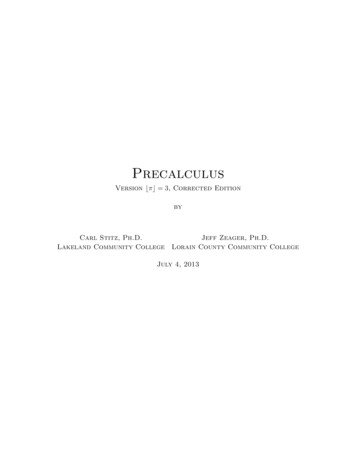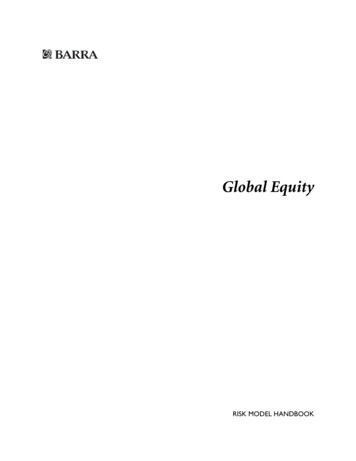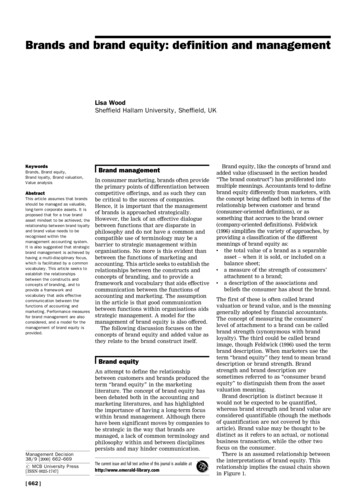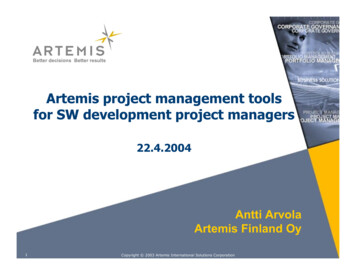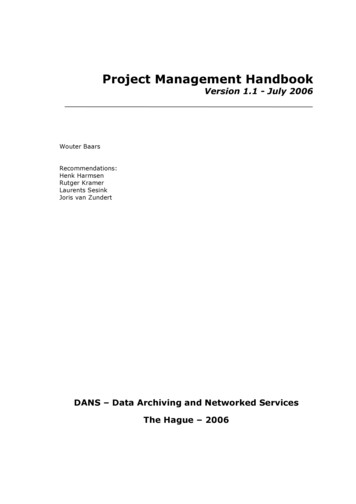
Transcription
Project Management HandbookVersion 1.1 - July 2006Wouter BaarsRecommendations:Henk HarmsenRutger KramerLaurents SesinkJoris van ZundertDANS – Data Archiving and Networked ServicesThe Hague – 2006
DANS – Data Archiving and Networked ServicesPO Box 930672509 AB The HagueT 31 (0)70-3494450F 31 (0)70-3494451info@dans.knaw.nlwww.dans.knaw.nlISBN 90 6984 496 6This work is licensed under the Creative Commons AttributionNon-Commercial-Share-Alike 2.5 License.To view a copy of this license, /2.5/or send a letter to:Creative Commons543 Howard Street – 5th floorSan Francisco, CA 94105USA
Table of ContentsForewordIntroduction1234567The six phases of project managementManaging a projectProject reportingThe sales representative and the politicianWaterfall versus cyclical project managementDANS software-development working methodsProgramme managementAppendices1. Top 11 causes of delays in IT projects2. Roles within a project3. Helpful resources for project management4. License for this handbook5. About DANS and the producers of this handbook6. Sample action-and-decision list7. Sample issue log8. Sample risk log9. Sample meeting report10. Sample project plan11. Sample budget12. Sample financial statementLiterature and Internet sourcesProject Management Handbook, version 1.1http://www.projectmanagement-training.net1
ForewordAnyone who has ever worked on a project will agree that making a project succeedis no simple task. The difficulties manifest themselves in (extreme) delays,(extreme) budget over-runs, inadequate results, dissatisfied customers, high stressamong the project team and other undesirable outcomes. What is the cause of allof these problems?Projects are characterised by four features: a group of people, a goal, limitedtime and money and a certain level of uncertainty regarding whether the goals willbe achieved. Project managers are involved with all of these aspects. Supervisingand directing a project is thus anything but an easy task.Projects are becoming increasingly common. Project-based working methodshave also found their way into non-profit organisations, including DANS.1 The rulesof the game for projects in non-profit organisations differ from those in commercialorganisations. Political factors play a particularly important role in non-profitorganisations. This makes it even more difficult for projects to succeed, comparedto projects in which commercial aspects play a part. Project leaders should beaware of this and be able to play the game of politics.After several years of experience with IT projects, the authors of this handbookhave become even more keenly aware of how IT projects differ from ‘regular’projects. Most importantly, projects are more dynamic, and that has bothadvantages and disadvantages. We have established that IT projects require anapproach that differs – at least partly - from the approaches that are appropriatefor construction, re-organisations or other types of projects.This handbook is intended for projects that are conducted by DANS. The firstsection describes a working method that can be followed for ‘traditional’ projects.The second section describes the working method for IT projects, particularly thosethat involve software development. This handbook presents a practical model thatwill allow project members, project leaders, project managers, general managers,programme managers, customers and project partners to play their roles withinDANS better.It is impossible to learn all there is to know about the field of projectmanagement. Theoretical development and practical experience are continuallyproducing new insights. This handbook is therefore incomplete, and it will growalong with new developments in the area of project management. To make thispossible, we have chosen to publish the text under a creative-commons license.This means that anyone is free to use, copy or change the text.2 Most importantly,it means that anyone who feels that the text is in need of additions or improvementshould not hesitate to do just that!Henk HarmsenDeputy DirectorDANSThe Hague, May 20061Data Archiving and Network Services (DANS) is a joint initiative of the Royal Netherlands Academy ofArts and Sciences (KNAW) and the Netherlands Organisation for Scientific Research (NWO), with the goalof improving the scientific data structure in the Netherlands.2For the exact terms of the license, please refer to Appendix 4.Project Management Handbook, version 1.1http://www.projectmanagement-training.net2
IntroductionThis project management handbook is intended for anyone who is involved in orwill be involved in projects that take place within or are conducted in associationwith DANS. The text, however, has been prepared in such a way that it can be usedby other organisations, particularly those in the non-profit sector, that use projectbased working methods.The book is comprised of several sections. The first section (Chapters 1 through4) provides an overview of project management. These chapters address thetheory of the waterfall method, which is applicable to most projects. The secondsection of this book (beginning with Chapter 5), addresses ‘cyclical’ forms of projectmanagement, which are more appropriate to IT-related projects. These methodsare particularly well suited for software development and other creative IT projects.The penultimate chapter addresses the working methods of DANS. This method is acombination of elements from both the waterfall and the cyclical methods. The lastchapter of this handbook discusses how organisations can manage the dynamics ofcarrying out several projects at once. The most important difficulties areaddressed, along with strategies for dealing with these problems.'This document includes a number of standard documents that can be used fordirecting projects, as well as a number of references to open-source projectinstruments developed by third parties. A literature list is included at the end of thisbook for those who wish to delve more deeply into the broad field of projectmanagement.Project Management Handbook, version 1.1http://www.projectmanagement-training.net3
1. The six phases of project managementThis chapter provides a sketch of the traditional method of project management.The model that is discussed here forms the basis for all methods of projectmanagement. Later chapters go into more depth regarding a model that isparticularly appropriate for IT-related projects.Dividing a project into phases makes it possible to lead it in the best possibledirection. Through this organisation into phases, the total work load of a project isdivided into smaller components, thus making it easier to monitor. The followingparagraphs describe a phasing model that has been useful in practice. It includessix phases:1.2.3.4.5.6.Initiation phaseDefinition phaseDesign phaseDevelopment phaseImplementation phaseFollow-up phaseFigure 1: Project management in six phases, with the central theme of each phase
Initiation phaseThe initiation phase is the beginning of the project. In this phase, the idea for theproject is explored and elaborated. The goal of this phase is to examine thefeasibility of the project. In addition, decisions are made concerning who is to carryout the project, which party (or parties) will be involved and whether the projecthas an adequate base of support among those who are involved.In this phase, the current or prospective project leader writes a proposal,which contains a description of the above-mentioned matters. Examples of thistype of project proposal include business plans and grant applications. Theprospective sponsors of the project evaluate the proposal and, upon approval,provide the necessary financing. The project officially begins at the time ofapproval. Questions to be answered in the initiation phase include the following: Why this project?Is it feasible?Who are possible partners in this project?What should the results be?What are the boundaries of this project (what is outside the scope of theproject)?The ability to say ‘no’ is an important quality in a project leader. Projects tend toexpand once people have become excited about them. The underlying thought is,’While we’re at it, we might as well ’ Projects to which people keep addingobjectives and projects that keep expanding are nearly certain to go off schedule,and they are unlikely to achieve their original goals.In the initiation phase, the project partners enter a (temporary) relationshipwith each other. To prevent the development of false expectations concerning theresults of the project, it makes sense to explicitly agree on the type of project thatis being started: a research and development project;a project that will deliver a prototype or ‘proof of concept’;a project that will deliver a working product.The choice for a particular type of project largely determines its results. Forexample, a research and development project delivers a report that examines thetechnological feasibility of an application. A project in which a prototype isdeveloped delivers all of the functionalities of an application, but they need not besuitable for use in a particular context (e.g. by hundreds of users). A project thatdelivers a working product must also consider matters of maintenance, instructionsand the operational management of the application.Many misunderstandings and conflicts arise because the parties that areinvolved in a project are not clear on these matters. Customers may expect aworking product, while the members of the project team think they are developinga prototype. A sponsor may think that the project will produce a working piece ofsoftware, while the members of the project team must first examine whether theidea itself is technically feasible.Project Management Handbook, version 1.1http://www.projectmanagement-training.net1—2
Definition phaseAfter the project plan (which was developed in the initiation phase) has beenapproved, the project enters the second phase: the definition phase. In this phase,the requirements that are associated with a project result are specified as clearly aspossible. This involves identifying the expectations that all of the involved partieshave with regard to the project result. How many files are to be archived? Shouldthe metadata conform to the Data Documentation Initiative format, or will theDublin Core (DC) format suffice? May files be deposited in their original format, orwill only those that conform to the ‘Preferred Standards’ be accepted? Must thedepositor of a dataset ensure that it has been processed adequately in the archive,or is this the responsibility of the archivist? Which guarantees will be made on theresults of the project? The list of questions goes on and on.Figure 2: Expectations of a project (Illustration: Rachèl Harmsen)Project Management Handbook, version 1.1http://www.projectmanagement-training.net1—3
It is important to identify the requirements as early in the process as possible.Wijnen (2004) distinguishes several categories of project requirements that canserve as a memory aid: PreconditionsFunctional requirementsOperational requirementsDesign limitationsPreconditions form the context within which the project must be conducted.Examples include legislation, working-condition regulations and approvalrequirements. These requirements cannot be influenced from within the project.Functional requirements are requirements that have to do with the quality of theproject result (e.g. how energy-efficient must an automobile be or how manyrooms must a new building have?). Operational requirements involve the use of theproject result. For example, after a software project has been realised, the numberof malfunctions that occur must be reduced by ninety per cent. Finally, designlimitations are requirements that involve the actual realisation of the project. Forexample, the project cannot involve the use of toxic materials or internationalpartners for whom it is unclear whether they use child labour.During the definition phase of a project that involved developing a web applicationfor a consortium of large organisations, no agreements were made concerning thebrowser that would be supported by the application. The consortium assumed thatit would be Microsoft Explorer, because it was the browser that ‘everyone’ used.The programmers created the application in Firefox, because they worked with thebrowser themselves and because it had a number of functions that wereparticularly useful during the development. Because most of the websites that aremade for Firefox also look good in Explorer, the difference was initially notnoticeable. Near the end of the project, however, the customer began to complainthat the website ‘didn’t look good’. The programmers, who had been opening thesite in Firefox, did not understand the complaint.When the problem of the two browsers became clear, the programmers reacteddefensively, ‘Can’t they just install Firefox? After all, it is free’. The organisations,however, were bound to the bureaucratic-minded system administrators who, forsome possibly justified reason, refused to install Firefox in addition to Explorer.Even if they had wanted to install it, it would have involved a lengthy process, andthere would have been extra costs for the time that the system administratorswould have to spend on the task. It was ultimately decided that the applicationwould have to be made suitable for Explorer. That involved considerable extrawork, whereby the project ran even more behind schedule than it already had, andit was necessary to negotiate the extra costs. It was later discovered that thevarious organisations were working with different versions of Microsoft Explorer.It is very important that all parties that are involved in the project are able tocollaborate during the definition phase, particularly the end users who will be usingthe project result. The fact that end
Project Management Handbook Version 1.1 - July 2006 Wouter Baars Recommendations: Henk Harmsen Rutger Kramer Laurents Sesink Joris van Zundert DANS – Data Archiving and Networked Services The Hague – 2006 . DANS – Data Archiving and Networked Services PO Box 93067 2509 AB The Hague T 31 (0)70-3494450 F 31 (0)70-3494451 info@dans.knaw.nl www.dans.knaw.nl ISBN


